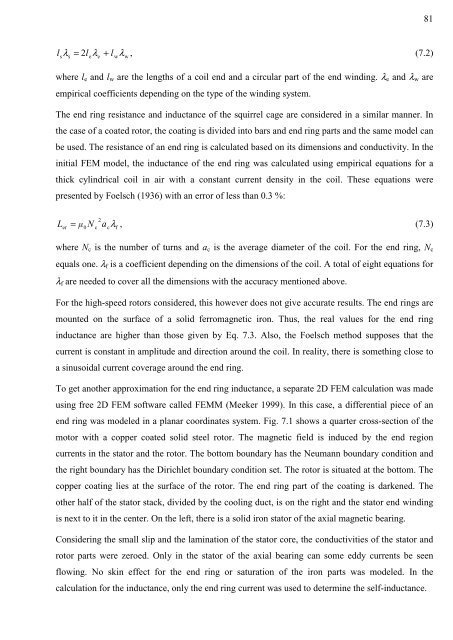Design and Voltage Supply of High-Speed Induction - Aaltodoc
Design and Voltage Supply of High-Speed Induction - Aaltodoc
Design and Voltage Supply of High-Speed Induction - Aaltodoc
You also want an ePaper? Increase the reach of your titles
YUMPU automatically turns print PDFs into web optimized ePapers that Google loves.
l = + , (7.2)<br />
sλs 2leλ e l wλ<br />
w<br />
where le <strong>and</strong> lw are the lengths <strong>of</strong> a coil end <strong>and</strong> a circular part <strong>of</strong> the end winding. λe <strong>and</strong> λw are<br />
empirical coefficients depending on the type <strong>of</strong> the winding system.<br />
The end ring resistance <strong>and</strong> inductance <strong>of</strong> the squirrel cage are considered in a similar manner. In<br />
the case <strong>of</strong> a coated rotor, the coating is divided into bars <strong>and</strong> end ring parts <strong>and</strong> the same model can<br />
be used. The resistance <strong>of</strong> an end ring is calculated based on its dimensions <strong>and</strong> conductivity. In the<br />
initial FEM model, the inductance <strong>of</strong> the end ring was calculated using empirical equations for a<br />
thick cylindrical coil in air with a constant current density in the coil. These equations were<br />
presented by Foelsch (1936) with an error <strong>of</strong> less than 0.3 %:<br />
er<br />
0<br />
2<br />
c<br />
L = N a λ , (7.3)<br />
c<br />
f<br />
where Nc is the number <strong>of</strong> turns <strong>and</strong> ac is the average diameter <strong>of</strong> the coil. For the end ring, Nc<br />
equals one. λf is a coefficient depending on the dimensions <strong>of</strong> the coil. A total <strong>of</strong> eight equations for<br />
λf are needed to cover all the dimensions with the accuracy mentioned above.<br />
For the high-speed rotors considered, this however does not give accurate results. The end rings are<br />
mounted on the surface <strong>of</strong> a solid ferromagnetic iron. Thus, the real values for the end ring<br />
inductance are higher than those given by Eq. 7.3. Also, the Foelsch method supposes that the<br />
current is constant in amplitude <strong>and</strong> direction around the coil. In reality, there is something close to<br />
a sinusoidal current coverage around the end ring.<br />
To get another approximation for the end ring inductance, a separate 2D FEM calculation was made<br />
using free 2D FEM s<strong>of</strong>tware called FEMM (Meeker 1999). In this case, a differential piece <strong>of</strong> an<br />
end ring was modeled in a planar coordinates system. Fig. 7.1 shows a quarter cross-section <strong>of</strong> the<br />
motor with a copper coated solid steel rotor. The magnetic field is induced by the end region<br />
currents in the stator <strong>and</strong> the rotor. The bottom boundary has the Neumann boundary condition <strong>and</strong><br />
the right boundary has the Dirichlet boundary condition set. The rotor is situated at the bottom. The<br />
copper coating lies at the surface <strong>of</strong> the rotor. The end ring part <strong>of</strong> the coating is darkened. The<br />
other half <strong>of</strong> the stator stack, divided by the cooling duct, is on the right <strong>and</strong> the stator end winding<br />
is next to it in the center. On the left, there is a solid iron stator <strong>of</strong> the axial magnetic bearing.<br />
Considering the small slip <strong>and</strong> the lamination <strong>of</strong> the stator core, the conductivities <strong>of</strong> the stator <strong>and</strong><br />
rotor parts were zeroed. Only in the stator <strong>of</strong> the axial bearing can some eddy currents be seen<br />
flowing. No skin effect for the end ring or saturation <strong>of</strong> the iron parts was modeled. In the<br />
calculation for the inductance, only the end ring current was used to determine the self-inductance.<br />
81
















